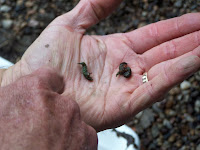As I have mentioned several times now, my investigation into the difference between
anadromous and
catadromous fish (a difference which you can learn about
HERE) resulted in me contacting
Dr. Joe Richardson,
Wallace Westfeldt, and
Larry Quilling with different questions about different fish that fit under both categories. Wallace Westfeldt is the Head Guide at Front Range Anglers (book a trip with him
HERE), and last year he came into my Outdoor Ed class to teach us about stream ecology. We also went on a field trip with him to scrounge up some aquatic
insects and insect larvae, and I've shared these pictures below the interview. Wallace had some interesting things to share about fishing for salmon as well, and I decided to make this another post in the anadromous/catadromous series!
 |
| Wallace Westfeldt holding a Steelhead in Idaho. By this point, these incredible fish have already swum 850 miles! |
The Natural World: We've been talking about salmon migrations here on the blog for the last few days. Have you ever had the opportunity to fish and/or see one of these mass migrations?
Wallace Westfeldt: Yes, I have been to
Alaska for the
Coho (Silver) Salmon migration; in 2012 and 2013. My trips were a little different than the norm. Most people go to the rivers, I was fishing in ocean at Yakutat. Here the Salmon feast on bait fish (mainly herring) to fatten up before going up river. We also spent some time inland at various river inlets where the fish would crowd and compete for going upriver. My fly was called a Seeker. When wet, it looks more like a herring than a herring does. However, I don't think fly choice is an issue. You need to get your hooks in front of a fish and they will eat. They are kind of crazy. In the ocean you are searching for baitballs and/or schools of Silvers. Baitballs are exactly what you would expect: massive spheres (10-30 in diameter) of bait fish swirling and the Salmon attack it.
 |
| A female Silver at sea. |
Getting solid hook-ups can be challenging. The mouth of a male Silver has an enormous overbite and is cavernous. It is important to get the fly deep in the mouth. When you seem them strike, you can see how aggressive they are for food. Their tiny little eyes can't see the end of their strike, so the mouth opens wide and goes from side to side to get its prey. I don't think they feel the pain of the hook, because when they would pop off at the skiff they would sometimes hit the next hook. However, when they feel the tug of the line they panic and put up an extraordinary battle to get away.
 |
| Another female. |
 |
| A male: check out the overbite! |
TNW: Where else have you been to catch anadromous fish?
WW: I have also been to
Idaho to catch
Steelhead trout. They swam 850 miles. We drove 900. They were in better shape than we were. Bitterly cold fishing, but excellent. When we hook up the fish would weave back and forth in the current, as if irritated, then they would take off. You weren't always sure who caught who. In truth the pictures I have don't represent how big they can get. Those were the ones I caught.
 |
| A steelhead. |
TNW: When you were in Idaho, 850 miles into the salmon journey, how much further did the Steelhead have to swim?
WW: We were near the end of their run by about 50 miles. Because Idaho is so far away from the ocean, they only get one run. Closer locations in
Washington and
Oregon get several.
TNW: I've noticed the overbite before, what purpose does it serve? It seemed to me that it came about only in the males, and after they were undergoing their pre-spawn transformation, is that correct? Does it play a role in attracting a mate?
WW: For Cohos, it's an overbite, for Browns, Bows, and Steelhead, it is an underbite, called a kype or kype jaw. As the male gets older there is always some evidence of the kype. However, you are correct that when in spawning mode, it gets more pronounced, as do the colors of Bows, Browns, and Chromers (steelhead nickname). You may also see other changes ... for example I caught a very large Brown once and it was particularly slimy. Trout have more slime than most fish because their scales are small and soft and don't offer any protection. So the slime is protective.
 |
| That's a Brown Trout caught in Mother Lake just west of Loveland. His name is Big Mike, slimy guy in pure spawn mode. |
I would like to take this opportunity to thank Wallace for taking the time to answer my questions! It was very informative, and really interesting! Thanks again, and make sure you check out his website by clicking
HERE! Before we go though, here are some of the pictures that I took while we were on the field trip with Wallace.



Unless otherwise noted, the photo credit for all of the photos in the post goes to Wallace Westfeldt.




















There are many different brands of fishing hooks available in market with different sizes and style to choose from. To understand the differences it is requires to move to basics and study the anatomy of hooks.
ReplyDelete